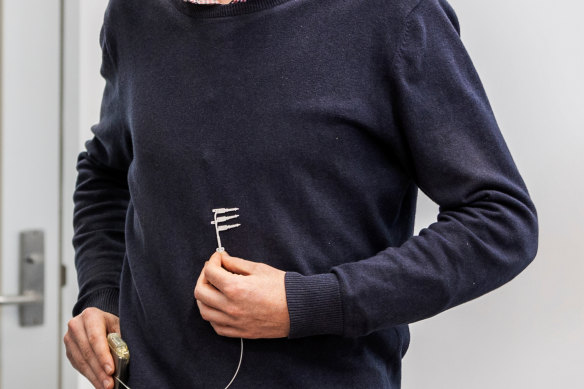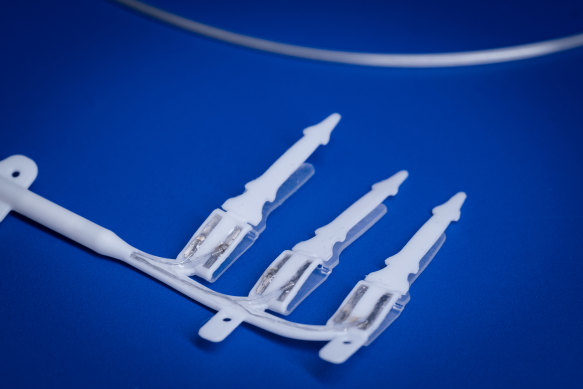By Liam Mannix
Place a finger on the hollow of your neck, where your jugular vein drums out the rhythm of your life.
Beneath this thick vein runs the vagus nerve, one of the major connecting cables between brain and body. It sends signals to the heart and lungs and nearly every other organ essential for your continued existence.

Sara Ferola has Crohn’s disease – an inflammatory disease that could one day commonly be the target of vagus nerve stimulation.Credit: Penny Stephens
The vagus is part of our parasympathetic nervous network: it calms and soothes the organs, dulls inflammation, stands down our immune armies.
A growing range of diseases – Alzheimer’s, rheumatoid arthritis, heart disease – are being linked to inflammation. What if we could trigger the vagus’ relaxing activity ourselves, scientists wonder. Could we treat those diseases?
In November, surgeons at the Austin Hospital made a small incision in the abdomen of patient Anthony Becker, who has the inflammatory bowel condition Crohn’s disease, and slipped three small platinum electrodes around the vagus nerve’s sheath.
The electrodes are wired to a stimulator about the size of two matchboxes that sends a 10-hertz burst for three hours.

The stimulator is the size of two matchboxes.
The hope: those signals will be read by the gut, brain and immune system as an order to cut down inflammation.
So far, so good. “He’s doing really well. He’s happy with life,” says Professor James Fallon, chief technology officer at the Bionics Institute in Melbourne, which designed the device. “He lost his remote control at one point. And that’s the biggest complication we’ve had so far.”
Fallon imagines implanting the stimulator in thousands more people as a tool to slow the progress of chronic disease.
“I see a future where not everyone, but lots of people, might end up with a device like this.”

The small electrodes that send signals to the nerve.
That’s if he can prove it works. Despite more than 125 years of research, the nerve remains mysterious, its full power untapped.
“We have a good handle on the fact [stimulators] work,” says Dr David Farmer, who studies vagus signalling at Monash University. “But we don’t know exactly what the mechanism is.”

“I will always have hope that there is a treatment like this device that will give me a better quality of life,” says Ferola.Credit: Penny Stephens
Eastern spiritualists were some of the first vagus stimulators. The nerve can be triggered simply by slowing your breathing. Meditation, yoga and mindfulness are all efforts to send calming signals down the cable.
In the 1880s, scientists discovered they could stimulate the nerve with electricity. Since then, approved treatments for epilepsy and depression have been developed largely through trial and error, says Andrew Butler, a vagus nerve researcher at the Florey Institute.
Scientists who work on the vagus hope that focusing now on inflammatory diseases, like Crohn’s or rheumatoid arthritis, will open up a broad new frontier.
Sara Ferola developed Crohn’s disease soon after having her son, Jaxon. She remembers “feeling very foggy and tired” and then suffering from severe panic attacks. She lost 15 kilograms and tried various medications without success before finding an antibody therapy that worked.
But the approved therapies come with long lists of side effects.
“I will always have hope that there is a treatment like this device that will give me a better quality of life,” she says.
Even if researchers can prove stimulation works for a broader range of conditions, there is the safety concern: the stimulators need to be implanted inside a patient’s body.
Risks from that procedure have dogged spinal cord stimulators, and led Australia’s drug regulator to deregister several products this year.
To help prove safety and effectiveness, the Bionics Institute has just won $4.8 million from a US foundation to develop the next generation of stimulator and take it to further clinical trials.
James Fallon is confident hurdles can be overcome. “Our body is an amazing thing. If you get it to do what it’s built to do, just a little better, that’s fantastic.”
The Examine newsletter explains and analyses science with a rigorous focus on the evidence. Sign up to get it each week.